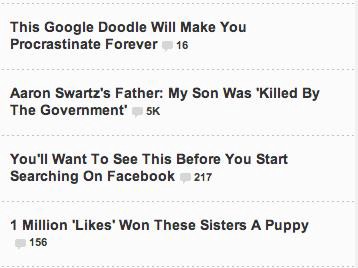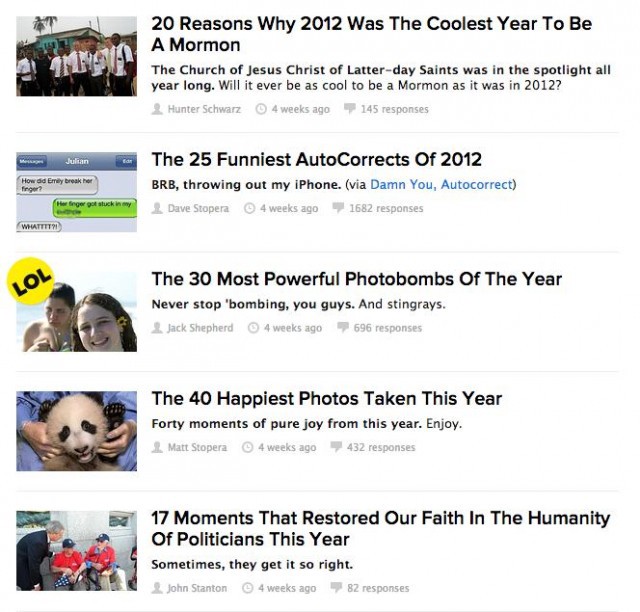Take A Minute To Watch The New Way We Make Web Headlines Now

The great menace in headlines in 2011 was that either every headline was “11 Ways to X” or that it was “Y Happens to Z [SLIDESHOW].” You know, whatever our pals at Business Insider and Huffington Post’s Celebrity Sideboob’s page were doing. Well, guess what, we all got used to it, and now it barely registers as tacky or grabby, except when it’s over the top. Sure: promise me 11 things, I will at least read three of them. Fair’s fair.
The menace before that was the “How” headline, which is so hard to avoid. “How X Became Y.” “How Apple Something Something’d.” “How Your Mom Became Your Dad.” That kind of thing. We all use “how” because “The Story of…” is boring and gross as a headline. “How” will never die.
But that is all like Victorian poetry compared to the new headline colloquialism that flowered into dominance in 2012. Headlines now are a strange cross between imperative and inviting. The tone is soothing, seductive and at least a little bit demanding, like every character ever played by Linda Fiorentino.
Need an example? It uses constructions like “Take a Break,” as in this rather aggressively marketed headline from Gothamist.

I don’t know about you, but I was definitely ready for a Sandy break. (Hmm.)
These headlines don’t always include “you” directly; usually the “you” is implied. But they do often include “watch,” which blogs inherited from the bigger news sites, like CNN, which famously invite us to WATCH LIVE: TODDLER KILLED BY GOAT and the like constantly. (In a rare variant, websites invite other modes of consumption: “Read Floyd Landis’s Lawsuit Againt Lance Armstrong, Which The Government Could Join Any Day,” suggests Deadspin today.) This is a cousin to the “Here’s the Real Reason Why…” headlines, which is a time-honored go-to. Effective, but sometimes deathly.

(Spoiler: the real reason is that the “new Indian yuppie” wants is “a clean, quiet, comfortable, air-conditioned space, to work, meet friends or linger for hours, no questions asked.” Unlike, you know, everyone else everywhere. Which makes that headline a good bit overbuilt.)

Also headlines now often include a weird colloquial address. “Good Morning, X Happened to Y” is one of those weird situations. “Good morning” is a Deadspin classic. (Related: the use of “everyone.” As in: “Everyone Wants to Adopt This Adorable Three-Legged Dog Who Was Caught on Camera Stealing Pet Food from a Supermarket.”)
What’s oddest about this form of headline is that it’s disassociated from conveying news. Instead it conveys interaction. Headlines once were stuffed full of proper nouns. But it turns out, old-fashioned headlines don’t convey things that aren’t news well. “Three-Legged Dog Desirable”? Nope. It doesn’t work, because there’s nothing there. Nothing except “aww.” And service pieces — how to do x, why not to do y — need the help for their softness too.
Along the way, the second-person has become a bit overwhelming. For this, we can likely blame Thought Catalog, whose entire industry is about the “you”: “The Cycle Of Love You’ll Go Through With Your Phone.” And so on. It spreads! Today, on BuzzFeeᴅ: “The 10 Places You’d Rather Be Right Now” and “Hey, You’re Doing A Really Good Job Today!” (That’s not true, I am not.)
This headline style hit the big leagues finally, with Stephen Rodrick’s Times Mag piece on Lindsay Lohan, with the headline “Here Is What Happens When You Cast Lindsay Lohan in Your Movie.”
Fascinated by web headlines that begin “Here Is” or “This Is.” Why do we need to be told it’s “here” or it’s “this”? ow.ly/gKG2F
— Zachary Pincus-Roth (@zpincusroth) January 14, 2013
Out of context, it’s jarring.
A lot of this vernacular arrived at Gawker at the same time that AJ Daulerio arrived at Gawker from Deadspin. [Note: Cause, effect, coincidence: no idea.] Now it’s totally saturated. “This Guy Is The Reason Hurricane Sandy’s Wikipedia Page Didn’t Mention Climate Change Until Today” was the Gawker repackaging of Popular Science’s headline “Meet The Climate Change Denier Who Became The Voice Of Hurricane Sandy On Wikipedia.”
[Update: And here’s a funny iteration: “I Can’t Stop Staring At….” Google results are heavily Gawker Media sites.]
Here’s a flashback. In 2007, a popular video of a baby getting dropkicked by a breakdancer (hard to believe I just typed that) was headlined “Times Square Still Extremely Unsafe for Children” on Gawker, which is pretty so-so as a headline but still funny. There’s no way that would get that headline now. (“Breakdancing in Times Square — Baby goes flying!” was the YouTube video headline.) “Watch This Baby Get Drop-Kicked By a Subway Breakdancer” is what I’d predict for our age. You have to really tell the folks on Twitter what’s happening for your clicks ’n’ shares, you see.
One other note: this is pretty distinctly American. You won’t catch a whiff of it on The Daily Mail.
Another part of it is the BuzzFeeᴅ “joy” component. The headlines come to offer the “you” pleasure and entertainment. Here’s back-to-back stories from their “Best of 2012” page.

Now that’s a lot of enthusiasm.
And the real problem is… overall, these new headline actions are infectious. Once you hear the headlines this way, and get into their rhythm, you can’t stop.
• Here’s the First Trailer for Harmony Korine’s Contra-Disney Movie, Spring Breakers.
• Watch this: Sony assembles three of its hottest gadgets in just five minutes.
• How the American Who Outsourced His Own Job to China So He Could Watch Cat Videos Could Have Gotten Away With It, According to the Man Who Caught Him.
• How Two Teams Found a Way to Lose a Three-Team Trade.
• Here’s The Big Beautiful BMW That Will Replace The 3 Series Coupe.
• Who Wants To Read 120,000 Pages Of Boy Scout Sex Abuse Documents?
• Why You Shouldn’t Find A Job On Craigslist.
• Meet The Man Who “Made Love” To A Dolphin.
But I don’t want to perform or learn or observe any of these things. Nor do I want to meet any of these people, particularly the ones who have sex with dolphins. I mean, I might? But the real reason I don’t is because almost all these constructions are so passive; the verbs are so weak or insignificant. When you start looking for verbs, sometimes you hardly find any. “Here Is X” robs us of chances for passion and action. “Watch” boxes us in as consumers, just a pile of receptors down at the dark end of an Internet tube. These constructions acknowledge a truth: our actions are increasingly passive online, and we really are just looking for something to watch, click, share and receive.
Photo by Porsche Brosseau.
